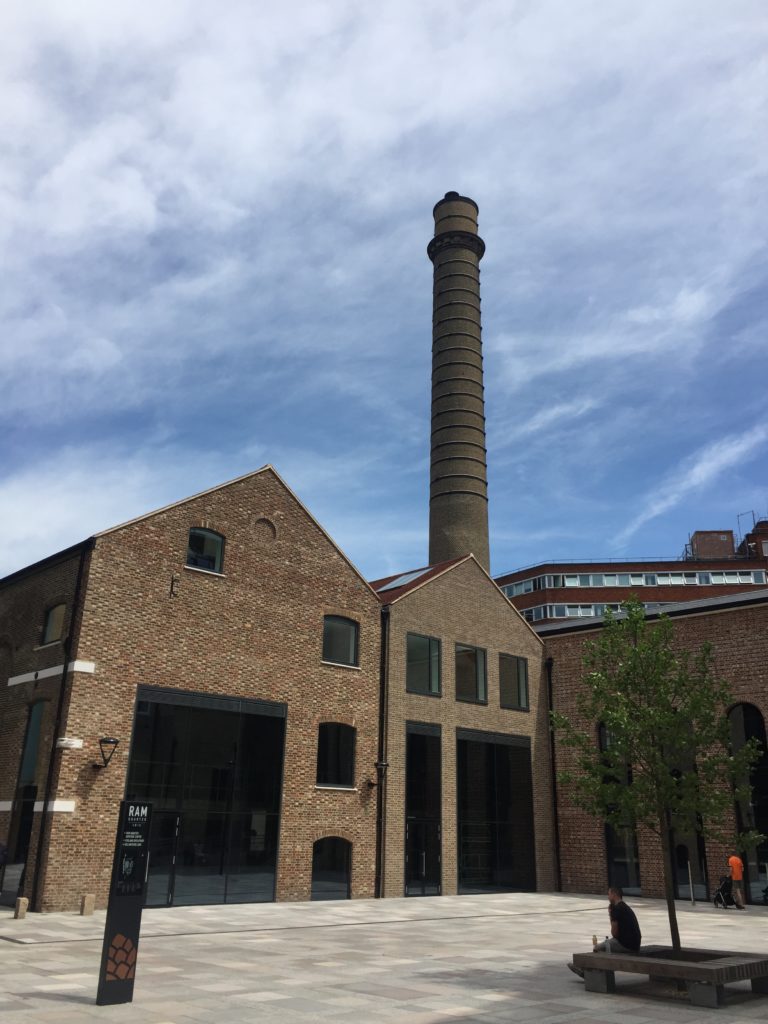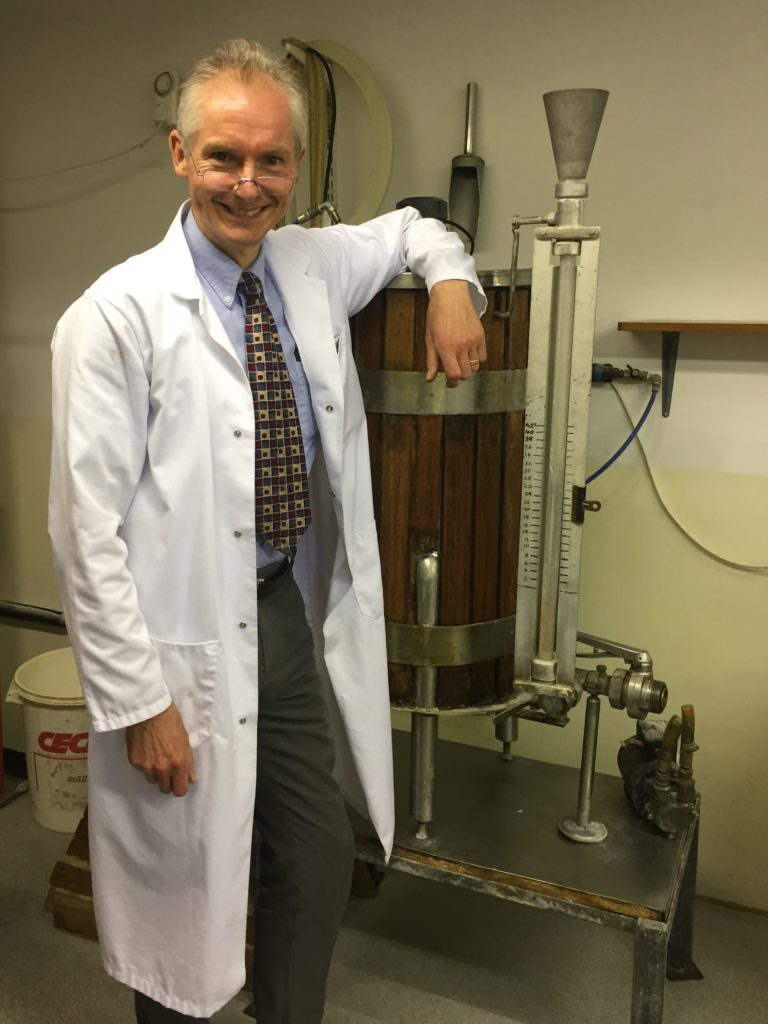
Includes information for Ram Brewery including historical information for Young’s & Co.
Brewery
Original site: 1 Yelverton Road SW11 3QG (Wandsworth)
Current site: 1 Bellwether Lane SW18 1UD (Wandsworth)
sambrooksbrewery.co.uk
First sold beer: November 2008
Ram Brewery
Closed/private brewery
68 Wandsworth High Street SW18 4LB
First sold beer: 1533 or before (as the Ram Inn)
Ceased brewing commercially: September 2006 (as Young & Co’s Brewery)
Continued brewing privately as the Ram Brewery 2007-20, now integrated into Sambrook’s.
Disappointed by the lack of locally brewed beer following the closure of Young’s at Wandsworth’s historic Ram brewery, city accountant Duncan Sambrook determined to do something about it. He created Sambrook’s with the help of veteran David Welsh, formerly of Ringwood brewery in Hampshire, becoming an early contributor to the current wave of London breweries. They installed a 33 hl Canadian-built brewhouse in a former photography studio not far from the river Thames in what was then one of the less sought-after areas of Battersea.

The brewery subsequently expanded into neighbouring units, and in 2013 co-founded a packaging facility, South Eastern Bottling (SEB) in Broadstairs, Kent, in partnership with two other breweries, Gadd’s and Westerham.
Sambrook’s owes at least some of its success to filling the niche left by Young’s, so there was a certain poetry to the announcement in 2019 that the business was relocating to the redeveloped Ram complex by spring 2020. This is the likely the oldest continuous brewing site in Britain, with records of an inn, the Ram, undoubtedly with its own brewhouse, on the corner of what’s now Ram Street and High Street in 1533. In 1581, it was occupied by a known brewer, Humphrey Langridge. By the late 18th century, it had developed into a successful porter brewery which had already expanded into adjacent buildings.
Its most famous owners, the Youngs, were prominent manufacturers of brewing vessels based in Southwark: it was a Young’s porter tun that triggered the Great Beer Flood of 1814. Charles Allen Young bought the Ram in 1831, initially in partnership with Anthony Bainbridge, though from 1883 the business was simply Young & Co, and had successfully moved from porter to brewing lighter, more sparkling beers. The site was rebuilt several times: much of what’s visible today was erected in the years following a major fire in 1882. The oldest surviving building is the 1724 brewer’s house on the High Street.
The beer consumer movement of the 1970s and 1980s knew Young’s as a fiercely independent fortress of brewing tradition, so it was a shock when in 2006, chairman John Young admitted he’d let his head rule his heart as he announced Young’s was partnering with Charles Wells and relocating all production to the latter’s big 1970s plant in Bedford. John, a great-great-grandson of Charles Allen Young, died aged 85 the very week his company brewed its last beer at the Ram.
Following an intervention by two Young’s staff, John Hatch and ex-Truman brewer Derek Prentice, Wandsworth council resolved to make provision of a microbrewery one of the conditions of planning permission for future redevelopment. John, a former homebrewer who had joined Young’s in 1988 as a biochemist before becoming brewhouse manager and health and safety supervisor, became site manager, and persuaded the new owner and Young’s to allow him to preserve the site’s brewing heritage using a nanobrewery, but only on condition the beer wasn’t sold.

One final gyle from the old brewhouse was used to fill bottles with a year’s supply of wort, keeping fermentation going while John cobbled together a tiny 50 l kit from bits and pieces found around the site. John served the beer from this in cask to visitors touring the site, film and TV crews working there and, later, to audience members at a series of popular comedy nights, with an honesty box to fund further brewing supplies.
Lacking a lab, John simply continued to repitch the Young’s yeast, which is now approaching its 1,000th regeneration and has developed a character of its own.
The arrangement was originally supposed to cover only a few years until space for a commercial brewpub became available on the site, but thanks to funding and planning delays and a change of ownership, John’s stopgap arrangement lasted for 15 years. The first new flats at the Ram were occupied in 2018, but it wasn’t until April 2021 that Sambrook’s brewed on the site, making a batch of its flagship Wandle Ale only 100 m or so from the river itself for the first time. This followed the unexpected additional delay caused by the 2020-21 Covid-19 lockdowns, during which John distributed free beer in polypins to local residents.
Part of the range of 1883 Grade II*-listed brewery buildings along Ram Street, including part of the pre-1980s brewhouse still complete with its Victorian coppers, had been set aside as a museum, bar-restaurant and brewery in the original plans. Sambrook’s new automated 20 hl kit has been carefully shoehorned in beneath low Victorian beams in the northern part of this complex, with John’s nanobrewery on a mezzanine above. The taproom, opened in July 2021, is in the former engine house, with the base of the chimney that dominates the site visible in an events space.
Adjacent to this, the old brewhouse now houses the heritage centre, displaying various items rescued by John as well as the coppers and the former brewery well, uncovered during the redevelopment. Currently this is only open for pre-booked tours. The brewery yard has become a public space, making it possible to appreciate many of the historic buildings from the outside.
Sambrook’s beers are widely distributed in cask, keg, bottle and can, the last two packaged at SEB. Ram Brewery beers are normally in cask, with occasional hand bottling, for sale in the taproom and at special events.
In a separate development, the Ram Inn pub, which remained in Young’s ownership, was reopened in 2019 as a brewpub, brewing under the name SlyBeast.
More about the current Young’s pub company and beers.
Updated 15 December 2021.





Leave a Reply